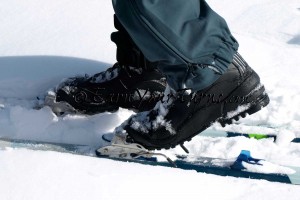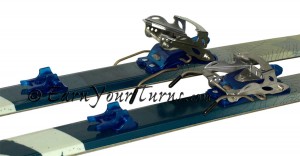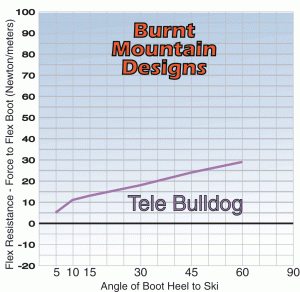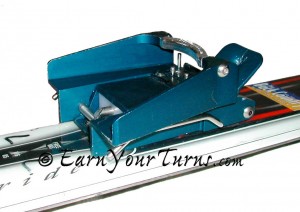When the original Tele Bulldog was introduced back in 2001 it seemed to be a solution without a problem. In the minds of the majority of backcountry nordic skiers, whether telemark or cross-country, it still is. But then, inventors like Louis Dandurrand aren’t necessarily motivated by huge profits as much as the desire to see their idea brought to fruition.
Enter the Tele Bulldog and it’s family of variations on the step-in theme, from the second generation Lite Dogz to the power-tube enhanced NT and RT Bulldogs and new for 12/13, Spike, with a pair of power-tubes attached at the heel. More on those as the new season gets underway. Half of the natural skepticism the Bulldog raised when introduced ten years ago was how chunky it looked. Considering it was machined from a block of aluminum this conclusion was hard to avoid. But when Louis Dandurrand explored having 22 Designs distribute his binding they realized he could fashion the basic toe piece like the Hammerhead toe – as a unitary, wrap-around piece of stainless steel – and the Bulldog became the Lite Dogz. It not only looked stronger and lighter, it was. And the simple, step-in functionality only became more believable.
By themselves the Lite Dogz weigh in at 1 lb, 10 oz. per pair. Like the TeleBulldog, the Lite Dogz comes standard with ski brakes and uses the 4-hole Targa mounting pattern. Contrary to the classic 3-pin design, these bindings work by having the boot and toe plate simultaneously clamp down on the 3-pins, rather than aligning your boot over the pins and then clamping the bale on the boot toe.
In the world of three-pin performance there is no better binding available. Not only are the Lite Dogz easier to get in and out of than any other 3-pin binding, they also ski better. The reason is simple, though not necessarily dramatic. Only advocates of 3-pin simplicity might notice, but in a side by side comparison the difference is undeniable. Because of how firmly the LiteDogz squeezes the duckbill, and because it does so over a larger surface area, and the fact the pins are larger diameter, and taller, improves the overall retention of a duckbill. That translates into greater control for turns, and slightly more resistance when touring.One of the best features of the Lite Dogz are the ski brakes. With the brakes you eliminate the annoying need for ski leashes, and bending over to put them on.
Is there anything not to like about the LiteDogz? Just the price. As a not so simple 3-pin binding the cost of having better control when downhill skiing and step-in convenience will add at least $100 to the price for a pair. Is it worth it? In the short run it may be hard to justify, but in the long run the simplicity and reliability of the step-in feature is hard to overlook. The only question is, are you willing to pony up for the Mercedez Benz of 3-pin bindings?Burnt Mountain Designs
Lite Dogz (DISCONTINUED 2011)
Price: ~$150
Weight/pair: 1 lb., 10 oz.
Replaced by Spike 3-pin, available in limited quantities Fall 2012
© 2012





2 pings
[…] freely, yet locked securely. The only 3-pin binding easier to get into is Burnt Mt. Design’s TeleBulldog, the first and still only true step-in telemark binding. Alas, with a stainless steel frame, it is […]
[…] Brnt Mt. Spike Lite […]